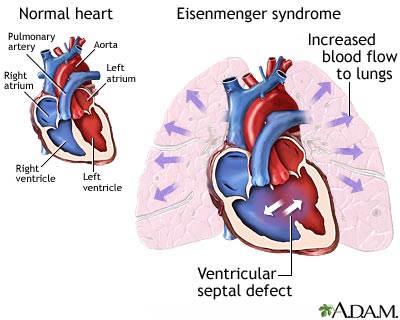Eisenmenger syndrome is a condition that affects blood flow from the heart to the lungs in some people who were born with structural problems of the heart.
Causes
Eisenmenger syndrome is a condition that results from abnormal blood circulation caused by a defect in the heart. Most often, people with this condition are born with a hole between the two larger pumping chambers -- the left and right ventricles -- of the heart (ventricular septal defect). The hole allows blood that has already picked up oxygen from the lungs to flow back into the lungs, instead of going out to the rest of the body.

Other heart defects that can lead to Eisenmenger syndrome include:
- Atrioventricular canal defect
- Atrial septal defect
- Cyanotic heart disease
- Patent ductus arteriosus
- Truncus arteriosus
Over many years, increased blood flow can damage the small blood vessels in the lungs. This causes high blood pressure in the lungs. As a result, the blood flow goes backward through the hole between the two pumping chambers. This allows oxygen-poor blood to travel to the rest of the body.
Eisenmenger syndrome may begin to develop before a child reaches puberty. However, it also can develop in young adulthood, and may progress throughout young adulthood.
Symptoms
Symptoms include:
- Bluish lips, fingers, toes, and skin (cyanosis)
- Rounded fingernails and toenails (clubbing)
- Numbness and tingling of fingers and toes
- Chest pain
- Coughing up blood
- Dizziness
- Fainting
- Feeling tired
- Shortness of breath
- Skipped heartbeats (palpitations)
- Stroke
- Swelling in the joints caused by too much uric acid (gout)
Exams and Tests
The health care provider will examine the child. During the exam, the provider may find:
- Abnormal heart rhythm (arrhythmia)
- Enlarged ends of the fingers or toes (clubbing)
- Heart murmur (an extra sound when listening to the heart)
The provider will diagnose Eisenmenger syndrome by looking at the person's history of heart problems. Tests may include:
- Complete blood count (CBC)
- Chest x-ray
- Electrocardiogram (ECG) to check the electrical activity in the heart
- MRI scan of the heart
- Putting a thin tube in an artery to view the heart and blood vessels and measure pressures (cardiac catheterization)
- Ultrasound of the heart (echocardiogram)
The number of cases of this condition in the United States has dropped because providers are now able to diagnose and correct the defect sooner. Therefore, the problem can be corrected before irreversible damage occurs to the small lung arteries.
Treatment
Affected people may receive oxygen, although it is unclear if it helps to prevent the disease from getting worse. In addition, medicines that work to relax and open the blood vessels may be given. People with very severe symptoms may eventually need a heart-lung transplant.
Outlook (Prognosis)
How well the affected person does depends on whether another medical condition is present, and the age at which high blood pressure develops in the lungs. People with this condition can live 20 to 50 years.
Possible Complications
Complications may include:
- Bleeding (hemorrhage) in the brain
- Congestive heart failure
- Gout
- Heart attack
- Hyperviscosity (sludging of the blood because it is too thick with blood cells)
- Infection (abscess) in the brain
- Kidney failure
- Poor blood flow to the brain
- Stroke
- Sudden death
When to Contact a Medical Professional
Contact your provider if you or your child develops symptoms of Eisenmenger syndrome.
Prevention
Surgery as early as possible to correct the heart defect can prevent Eisenmenger syndrome.
Alternative Names
Eisenmenger complex; Eisenmenger disease; Eisenmenger reaction; Eisenmenger physiology; Congenital heart defect - Eisenmenger; Cyanotic heart disease - Eisenmenger; Birth defect heart - Eisenmenger; Eisenmenger's syndrome
References
Bernstein D. General principles of treatment of congenital heart disease. In: Kliegman RM, St. Geme JW, Blum NJ, et al, eds. Nelson Textbook of Pediatrics. 22nd ed. Philadelphia, PA: Elsevier; 2025:chap 483.
Therrien J, Marelli AJ. Congenital heart disease in adults. In: Goldman L, Cooney KA, eds. Goldman-Cecil Medicine. 27th ed. Philadelphia, PA: Elsevier; 2024:chap 55.
Valente AM, Dorfman AL, Babu-Narayan SV, Krieger EV. Congenital heart disease in the adolescent and adult. In: Libby P, Bonow RO, Mann DL, Tomaselli GF, Bhatt DL, Solomon SD, eds. Braunwald's Heart Disease: A Textbook of Cardiovascular Medicine. 12th ed. Philadelphia, PA: Elsevier; 2022:chap 82.
Review Date 2/27/2024
Updated by: Thomas S. Metkus, MD, Assistant Professor of Medicine and Surgery, Johns Hopkins University School of Medicine, Baltimore, MD. Also reviewed by David C. Dugdale, MD, Medical Director, Brenda Conaway, Editorial Director, and the A.D.A.M. Editorial team.



